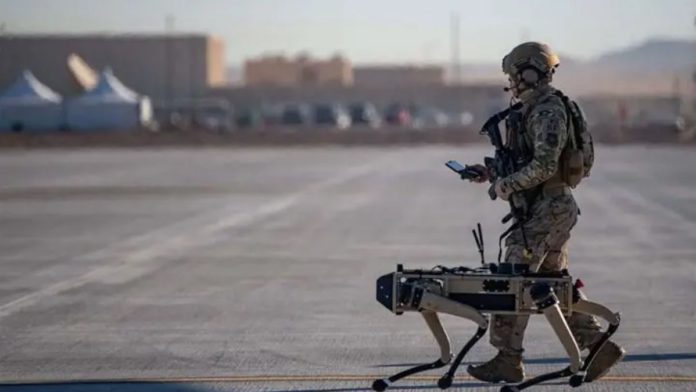In a futuristic turn of events, the U.S. Department of Homeland Security (DHS) recently announced it has been working with the Philadelphia-based company Ghost Robotics to develop robot dogs for patrolling at the US-Mexico border.
These 100-pound quadrupeds were designed to scale all forms of natural terrains, such as sand, rocks, and hills, as well as man-made environments, such as stairs. Each robot dog is equipped with a variety of sensors and is capable of transmitting live video and data streams. The devices are not currently operational on the US-Mexico border, but they are being tested and evaluated in El Paso, Texas. These robots would eliminate the need for human people to be exposed to extreme temperatures and other dangers near the border.
“The southern border can be an inhospitable place for man and beast, and that is exactly why a machine may excel there,” added DHS Science and Technology Directorate manager Brenda Long.
Jiren Parikh, CEO of Ghost Robotics, said he couldn’t reveal any more details about the Border Patrol’s robot dogs, but some in development have unique sensors and can carry technology to detect narcotics, nuclear materials, and chemical weapons. The company has previously unveiled its robots at Tyndall Air Force Base in Florida as part of an effort to replace stationary surveillance cameras. Last year, during the Association of the United States Army’s annual conference in October, Sword International has unveiled an armed robot dog from Ghost Robotics with a custom-made weapon termed a “special purpose unmanned rifle” or Spur.

One of the most popular models from the Ghost Robotics, the Ghost Vision 60, measures 2.5 feet tall (76cm), weighs 70lbs (32kg), and can travel over 7.5 miles in 3 hours on a single battery charge. It is currently priced at $150,000, with specialized sensors or other add-ons costing extra. The government has not said how many robots it plans to buy or how much the program would cost.
The Science and Technology Directorate, which advises Homeland Security on research and development, began collaborating with US Customs and Border Protection and Ghost Robotics to create and test a border patrol robot for a period of 2.5-years. The Ghost Vision 60 has to be modified to function in adverse weather conditions and isolated regions in order to work at the border. The robots delivered to DHS can work in temperatures ranging from -40 degrees Celsius to 55 degrees Celsius and can also withstand submerged conditions. Before being shifted to El Paso, Texas, for further trials in tougher environments, robot dogs went through intensive testing in Lorton, Virginia.
Read More: Introducing LEO: Caltech’s Humanoid Robot can Fly, Walk, and Jump
While the idea of deploying robot dogs to patrol at the US-Mexico border sounds like exciting usage of robotics, not all feel the same about this initiative. According to Fernando García, executive director of the Border Network for Human Rights, “Instead of fixing our immigration systems, understanding the pushes and pulls of the immigration process and try to actually fix what is broken. We continue to invest in this enforcement-only approach that includes this technology.” Many have objected to adding robot dogs to the already militarized US-Mexico border.
Further employment of robots dogs does not have a good reputation so far. For instance, in 2021, the New York City Police Department (NYPD) had deployed a canine-like robot nicknamed Digidog at Manhattan public housing complex. This remote-controlled bot was created by Boston Dynamics, a robotics company known for viral videos of robots dancing and sprinting with human-like skill. However, after a public outcry over ethics and privacy, the NYPD was forced to end this initiative.
Not long time ago, the Honolulu Police Department recruited Boston Dynamics’ Spot to scan the eyes and measure temperatures of homeless citizens to check for Covid signs. Even this step was heavily criticized as dehumanizing.
Meanwhile, Parikh assures that the robots dogs from Ghost Robotics at US-Mexico border are not autonomous yet and people should not be worried. Although, the whole development of robotic dogs begs a question, “Do we seriously need robots to keep an eye on human activities – illegal or not?” Are we racing towards a dystopian future or a world on the quagmire of ethical rights?


